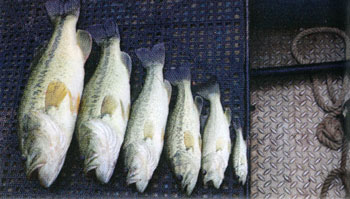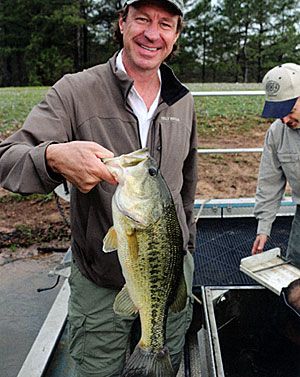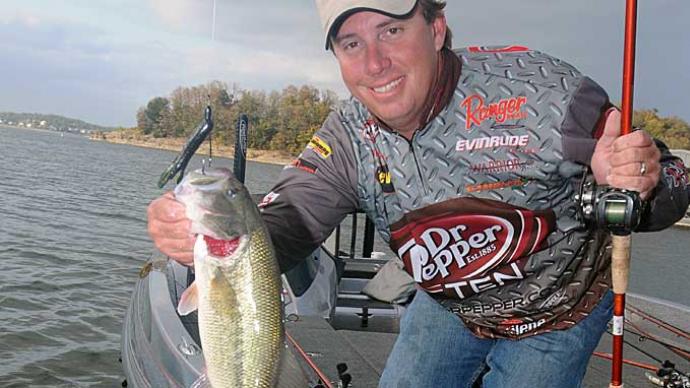
You've heard it from every pond management pulpit in the nation, the four books of the gospel offish management in your pond: Habitat, Food Chain, Genetics and HARVEST. Not only are we called to be fishers of men, we are chosen to be fishers of fish, too—if we own a pond.
There are a couple of guys in Oklahoma, kin by marriage, who tend to have friendly debates about what fish to take, and which to leave behind, so to speak. I'll always remember when they first built their lake. They designed good cover, good variety of habitat, had plenty of watershed, built a nice dock, stocked the lake with the best choices of fish, fed the slippery little creatures, and then watched them grow. They'd read all about harvest, and those concepts were drilled into their minds.
Drilled a little too deep, as it turned out.
They knew to harvest all bass under 14 inches. But, the debate started over harvest timing. Someone missed the memo on this strategy, because those guys started harvesting their newly stocked fish when they grew to catchable sizes, rather than waiting for them to reproduce and then harvesting their babies when they grew to 12-14"—around year 3 or 4. By the end of the second year, they were upside down. They'd harvested their best fish, the ones with the best potential for growth. After that, it was a guessing game as they tried to catch up. Young fish did what they could to fill the empty slot, but it didn't seem to work as it should. To this day, those two fellows still debate what to keep, what to release, how to handle fish, and when to do it.
Here it is, straight and simple. When you stock fish by the book, you are creating a system intended to grow, populate, and expand numbers. Those originally stocked game fish are stocked in numbers for their destiny to be death by old age, not in a skillet. When they begin to reproduce, you take their babies. Wait at least until the third year before you harvest fish.
Disagree with these last statements? So do I—but I didn't write the book.
Let the fish tell you when it's time. It's really simple.
Your bass will gain weight when they have food. They will grow fast when young—if they have the best genetics, adequate habitat, and a legitimate opportunity. At some point, their growth rates will level off, and you get to figure out when and why. Is it because that population has reached a point of saturation where they are overeating their food chain? If you are constantly catching fish that look normal or slightly thin, you've probably reached that point.
That's a sign.
If you are way past that third year, look at the body condition of your game fish, whether they are largemouth bass, channel catfish, smallmouth, or bluegills. If they are thin, assume they are losing weight. If high numbers of that population are losing weight, that's a sure sign you need to harvest some fish. Or, ramp up the feed. If you ramp up the feed, you are putting off the inevitable. You'll still want to harvest fish.
Selective harvest is the game. Keep your goals in mind. If your goals are to grow big bass, then preserve your biggest bass, and cull those smaller ones that you think inhibit the growth of your big bass. But, keep in mind that you have to keep a junior varsity growing in your pond to provide bigger bass later. That means discernment on your part. If you decide that 16-inch and smaller bass need to be harvested, keep in mind that a high percentage of your 16-inch bass are girls. With largemouth bass, girls grow big; boys don't.

When you harvest, keep other things in mind, too. Remember that word, selective. Be picky about what you take. If your bass population is obviously way overcrowded with old fish, take all you can catch. But, if you are in the third, fourth or fifth year of your management plan, and you catch a 14-inch bass that looks like a couch potato, release it. That may be the fish with the right stuff to push into double digits in a few years. If you catch another 14 incher right behind that one, and it has a concave belly and one eye, take it out.
Think about that concept some more. The book says to remove fish in a slot. But, you have discretion. You must harvest fish, but only when the time is right. You get to figure out when the time is right. Then, you get to choose which fish to remove. That's really important. I'm convinced many ponds have suffered deep harm because those pond owners weren't selective enough. The best rule of thumb is to judge body condition. Here's some good science-based advice. If a bass is 85% or less of its desired condition, odds are high it won't recover enough to grow to sizes you want.
So, that concept is pounded into your head and you've taken the bait.
Got a call the other day from a Pond Boss reader. He and I were talking about this subject and he asked a thoughtful question. "Bob, what do we do about fish we deep hook?"
There are several ways to think about that, but you have to make a quick decision.
If you deep hook a fish, there are devices at fishing stores that aid in removal of deep hooks. If you don't have one of those, and you deep hook a fish you want to release, you have several options. The best option is to pull the gill flap back, reach through the gills with needle-nosed fishing pliers, and grab the hook near the curve. Twist the pliers the same direction the hook penetrated and it will pop right out. Then, pull the pliers out, reach down the mouth, grab the hook, and pull it out.
If you can't figure out how to do that, cut the line off the hook, and push the hook further down into its gut so as not to obstruct its throat. Don't rip the hook out through the fish's mouth, or you'll damage the tissue enough to kill the fish. Believe it or not, the fish will digest that hook. It will take a while, but it will do it. If you hook a fish in its gills, and it bleeds, odds are high that it will not make it. If it doesn't bleed, it has a chance. Cut the line, lift the gill plate, and see if you can pull the hook through. Don't tear any tissue. Loss of too much blood is inevitable death, so avoid that.
Another question came across our desk. Last issue, I wrote a story about handling fish. Seems there's some debate as to what size bass can be safely lifted by its bottom jaw. My opinion is a bass larger than 5 or 6 pounds deserves to be held under its belly. Sure, hold it by its lip, but don't put forward pressure to crack its jaw, no matter the size.
Just as you manage your water to keep it healthy, manage your fishery as a precious resource, too. Yes, they are fish. Yes they'll reproduce. But, part of your role as steward is to be thoughtful about your fish. I'm not telling you to treat them as pets—heavens no—but don't treat them as some simple commodity, either.
And, if you deep hook one, be sure you've got the tools needed to remove that hook. You never know—several years from now, that fish you hook deep today may set a new lake record.
Reprinted with permission from Pond Boss Magazine



